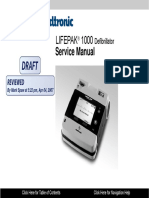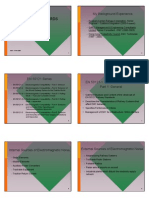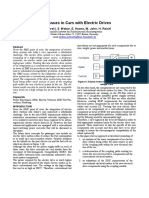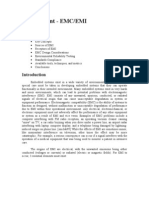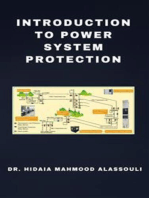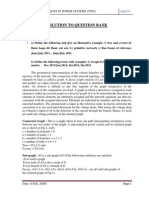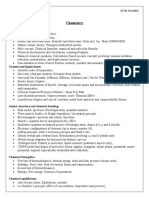Electromagnetic Compatibility in Power Electronics: 5th Lecture, 2 October 2013
Electromagnetic Compatibility in Power Electronics: 5th Lecture, 2 October 2013
Uploaded by
anirudh.r.s.Copyright:
Available Formats
Electromagnetic Compatibility in Power Electronics: 5th Lecture, 2 October 2013
Electromagnetic Compatibility in Power Electronics: 5th Lecture, 2 October 2013
Uploaded by
anirudh.r.s.Original Title
Copyright
Available Formats
Share this document
Did you find this document useful?
Is this content inappropriate?
Copyright:
Available Formats
Electromagnetic Compatibility in Power Electronics: 5th Lecture, 2 October 2013
Electromagnetic Compatibility in Power Electronics: 5th Lecture, 2 October 2013
Uploaded by
anirudh.r.s.Copyright:
Available Formats
Electromagnetic Compatibility in Power
Electronics
5th Lecture, 2 October 2013
M.Sc. Juho Tyster
tyster@lut.fi
Lecture contents
EMC measurements
Case study: EMC in electric vehicle applications
Subdivisions
EMI measurements for conducted and radiated EMI
EMI characteristics and challenges within the electric vehicle (EV)
EMI inside the EV
Radiated EMI
EV charging interface, smart grids
Grid interference
EMC measurements
Antennas
Antenna is any circuit element that couples the wave between
transmission line and surrounding space
Typical unintentional antennas in power electronics are the open-ended
wire agains ground plane, wire loop with current, or conductive plane,
chassis, etc. Against a ground potential
V
1
+
EM wave in
transmission line
EM wave in free
space
V
2
-
EM wave in
transmission line
Distance
Antenna 1
Antenna 2
Radiated EMI measurement
Radiated EMI is produced by the device under test (the power electronics
equipment), coupled through unintentional antennas
In EMI measurements, standardized antennas are used to receive these
radiated fields
Line impedance stabilizators
Electric supply grid impedance is not constant
Line impedance stabilization network (LISN) is a circuit that produces some
standardized grid impedance for measurement purposes
1 F
50 H
100 nF
1 k
50
L
N
G
CISPR 16-1 standard 50 / 50 H LISN for 150 kHz 30 MHz EMI
measurements
Grid side D.U.T. side
EMI out
Measurement methods for EMI
Conducted and radiated EMI is measured with EMI test receiver (a type of
radio frequency power meter), or less preferably, with spectrum analyzer
FCC (US) and CISPR (IEC/International) define the specifications for the
official test receiver
Suggested reading for details is the Henry W. Ott book
1
Details not required for understanding the principle
Conducted EMI: LISN + Test receiver + device under test
Radiated EMI: Test receiver + standard antennas + device under test
This all happens in an EMI room as defined by the standard
And once again, several national standards exist, such as FCC in North
America, CENELEC in Europe, and VDE in Germany
International procedures defined by IEC/CISPR
Generally very similar
1
[References: Noise Reduction Techniques in Electronic Systems,
Henry W. Ott, 2nd ed., Wiley 1988]
FCC: Radiated EMI test method
[References: Noise Reduction Techniques in Electronic Systems,
Henry W. Ott, 2nd ed., Wiley 1988]
FCC: Radiated EMI test method
[References: Noise Reduction Techniques in Electronic Systems,
Henry W. Ott, 2nd ed., Wiley 1988]
Challenges in antenna
position/radiation
pattern
FCC: Conducted EMI test method
[References: Noise Reduction Techniques in Electronic Systems,
Henry W. Ott, 2nd ed., Wiley 1988]
FCC: Conducted EMI test method
[References: Noise Reduction Techniques in Electronic Systems,
Henry W. Ott, 2nd ed., Wiley 1988]
LISN (Line Impedance
Stabilization Network)
provides a known
impedance in the input,
and isolates the setup
EMI from the grid.
LISN outputs the
interference voltage from
an RF connector
EMI test receiver
Basically an ordinary superheterodyne radio receiver with standardized
intermediate frequency (IF) filter and a power meter in form of a peak
detector
Measures the power across the EMI spectrum
Produces an EMI power spectrum estimate
This spectrum is compared to (national) limits
What the EMI receiver shows?
[Agilent web page http://www.agilent.com]
Limits, regulations
Comparing the test data with the regulation limits
[References: Noise Reduction Techniques in Electronic Systems,
Henry W. Ott, 2nd ed., Wiley 1988]
Class A: Office/Industrial
use
Class B:
Home/Consumer use
CISPR and EN limits, examples
E.g. CISPR (international) defines limits for typical equipment such as:
CISPR11: Industrial, medical, scientific
CISPR13: Consumer electronics
CISPR14: Home appliances (white goods), power tools
CISPR15: Lighting
CISPR22: Computers
EN 61800-3 for European markets of AC motor drives
Mainly interested in harmonic power quality in industrial AC drives
Limits depend on application type and target country
EMC in electric vehicles
EMI characteristics of an EV
Switching-mode power supplies, power cabling, and signal cabling
physically close together
Multiple junctions between cable harnesses, connectors
DC feed invites for bad cabling design
Separation between cables, current loops
ON THE OTHER HAND:
Car itself presents a good RF shield due to metal chassis
Vehicle EMI couples to the grid when charging
Main components
=
Charging converter Storage battery
Power interconnections
Grid
=
Motor converter
M
EV power electronics
Control
Integrated
charger/battery
Control bus
EMI inside EV
Power electronics itself is the same as in any SMPS applications
IGBT or MOSFET based converters
All the potential EMI sources as in previously discussed topics
Interconnection cabling is similar to solar applications
DC link interconnection harness
Battery/charger location vs. motor converter location
Failure to prevent common-mode path via e.g. bearings can be detrimental
to bearing life time
Transient operation vs. steady-state: EMI dependence on load conditions
Car acceleration/deceleration (electric braking)
Load profile
EMC inside the vehicle, standardization is developing
Interference in auxiliary electronics, radio/audio/video
EMI inside EV vs. in-car electronics
Power filtering adds weight, space requirement, and cost (true for any
system, but compare a car vs. industrial installation)
Conducted EMI with shared storage battery
Control electronics (critical), leisure electronics (user experience)
Battery is the common point of coupling for conducted EMI
Currently standard CISPR measurement method for conducted EMI is
unable to cope with load transients (e.g. acceleration)
Measurement standards for EV are still under development
Short-time Fourier transform-based spectrum analysis is better choice for
car power electronics
Typical problem in FM radio band
Interconnection shielding vs.
measurements
Use of shielded harnesses and cabling results in lower conducted EMI
Common-mode return path in shield vs. chassis
Location and cabling of line impedance stabilization network in
measurements vs. real-world vehicle application
Closest match when LISN connected to battery with shielded cable, with
shield connected at both ends
But CISPR standard LISN is badly suited for EV measurements
LISN
Battery
LISN
Motor
converter
DC+
DC-
Reducing SMPS-borne EMI
Spread-spectrum techniques employed
Variable switching frequency
Smaller filter size can achieve the same EMI level
Both battery charger and motor converter
Frequency
Power
Spread-spectrum
technique
Constant carrier
frequency
Radiated EMI in an EV
Communications electronics antenna field distribution is dependent on
passenger configuration [1]
Power electronics-borne radiated EMI sources typically outside the cabin
Field distribution still strongly dependent on chassis structure
Radiated EMI measurements standards are still developing [2]
Vehicle radiated EMI is still concentrated on combustion engine ignition
noise
Wrong frequency spectrum
[1] L. Low, A. R. Ruddle, J. M. Rigelsford, R. J. Langley, Computed Impact of Human
Occupants on Field Distributions Within a Passenger Vehicle, IEEE EUCAP 2011
[2] Ferran Silva and Marc Aragn, Electromagnetic Interferences from Electric/Hybrid
Vehicles, IEEE General Assembly and Scientific Symposium, 2011 XXXth URSI
Conclusions in in-car EMI
characteristics
CISPR etc. standards not well suited for EV EMI measurements
Wrong test methods and no mutual agreement in the industry yet
In principle the design methods are the same as e.g. photovoltaic
applications, and prevention follows normal power electronics design
practices
Car chassis is a good shield on itself, but external wiring harnesses can be
a major radiated EMI source
Grid-side interface
In case of all-electric vehicle, the storage battery is charged from the grid
Managing large number of charging EVs connected to the grid requires
some intelligence
Time distribution of charging events, and possible use of car energy
storage to meet grid peak power demand
Intelligent managing of distributed storages and charging, Smart Grid
Smart vs. grid power quality
Voltage sags, swells, individual EVs connecting to the grid
EVs vs. other power electronics directly connected to grid
Energy storage potential
Regulations still developing, new topic [3]
Smart does not mean the EMI problems are mitigated automatically
Still follows the design rules in grid interfaces, filtering etc.
EVs, photovoltaic power generation, fuel cell power, wind, all involve
direct connection of power electronics to the grid
[3] Magnus Olofsson, Power Quality and EMC in Smart Grid, IEEE 10th International
Conference on Electrical Power Quality and Utilization, 2009
You might also like
- LIFEPAK 1000 Service Manual PDFDocument174 pagesLIFEPAK 1000 Service Manual PDFanibal bravo100% (2)
- Electrical Design For Residential With Application of Philippine Electrical CodeDocument32 pagesElectrical Design For Residential With Application of Philippine Electrical CodeJane Erestain Buenaobra100% (1)
- Accuvix A30 SVM V3.0 Rev2 EngDocument315 pagesAccuvix A30 SVM V3.0 Rev2 EngBenjamin Gonzalez93% (15)
- Alcatel 1603SMX MaintenanceDocument940 pagesAlcatel 1603SMX Maintenance10gigtex100% (1)
- En 50121-3-2Document2 pagesEn 50121-3-2yunus emre Kılınç33% (3)
- En 50121 Railway StandardDocument4 pagesEn 50121 Railway StandardxclusivveNo ratings yet
- It Is Quite Another Electricity: Transmitting by One Wire and Without GroundingFrom EverandIt Is Quite Another Electricity: Transmitting by One Wire and Without GroundingRating: 4.5 out of 5 stars4.5/5 (2)
- SCL MCL 52 74 75 102 105 UsDocument109 pagesSCL MCL 52 74 75 102 105 UsAdalberto TiconaNo ratings yet
- ATrack AK1 ManualDocument16 pagesATrack AK1 ManualPedro PizarroNo ratings yet
- EMCtestreqforevDocument3 pagesEMCtestreqforevmail 2ghkNo ratings yet
- Ap7301 Emi&Emc NotesDocument126 pagesAp7301 Emi&Emc NotesMohanaprakash EceNo ratings yet
- Fair Report Without OutlineDocument38 pagesFair Report Without OutlinegokarnaNo ratings yet
- An Overview of EMI EMCDocument16 pagesAn Overview of EMI EMCVivek Shinde100% (1)
- EMI in Power SuppliesDocument16 pagesEMI in Power SuppliesHansraj AkilNo ratings yet
- EMC Chap 1Document43 pagesEMC Chap 1Karan SinghNo ratings yet
- EMI-EMC - SHORT Q and ADocument5 pagesEMI-EMC - SHORT Q and AVENKAT PATILNo ratings yet
- Understanding and Optimizing Electromagnetic Compatibility in Switchmode Power SuppliesDocument18 pagesUnderstanding and Optimizing Electromagnetic Compatibility in Switchmode Power SuppliesYeşim FiridinNo ratings yet
- Topic-2: by KK Sawant, Assistant Professor, EE DEPTDocument36 pagesTopic-2: by KK Sawant, Assistant Professor, EE DEPTmuvin236No ratings yet
- Electromagnetic Interference EMIDocument16 pagesElectromagnetic Interference EMIErnesto Vergara Jr.No ratings yet
- Fundamentals of Electromagnetic Compatibility (EMC) DesignDocument28 pagesFundamentals of Electromagnetic Compatibility (EMC) DesignSasidhar Reddy VundelaNo ratings yet
- EMC Plan For Metro PsDocument14 pagesEMC Plan For Metro PsXavi deMikaelNo ratings yet
- Electromagnetic Compatibility (EMC)Document32 pagesElectromagnetic Compatibility (EMC)Veljko TomaševićNo ratings yet
- Electrical Power Transmission 1Document5 pagesElectrical Power Transmission 1Ali RazaNo ratings yet
- EMC Issues in Cars With Electric Drives: S. Guttowski, S. Weber, E. Hoene, W. John, H. ReichlDocument6 pagesEMC Issues in Cars With Electric Drives: S. Guttowski, S. Weber, E. Hoene, W. John, H. ReichlVito LNo ratings yet
- Emc - Chip 2Document5 pagesEmc - Chip 2FemeiaOrtodoxaNo ratings yet
- Thesis A Roc'hDocument228 pagesThesis A Roc'hGaetano GaetanoNo ratings yet
- AP7301-Electromagnetic Interference and Compatibility Question BankDocument10 pagesAP7301-Electromagnetic Interference and Compatibility Question BankSujith KunjumonNo ratings yet
- Emi, EmcDocument13 pagesEmi, EmcKirthika Vinoth KumarNo ratings yet
- Ept Cep PDFDocument6 pagesEpt Cep PDFMuhammad SalmanNo ratings yet
- A Guide To Electromagnetic Compatibility For Variable Speed Drives-EmersonDocument28 pagesA Guide To Electromagnetic Compatibility For Variable Speed Drives-EmersonDelfinshNo ratings yet
- Emi EmcDocument15 pagesEmi Emckapilpatel100% (4)
- EMI-EMC-HIRF-4Document85 pagesEMI-EMC-HIRF-4goktuggokdemirrNo ratings yet
- Lab1_RLC circuitDocument11 pagesLab1_RLC circuittitanfallkillofweekNo ratings yet
- Best Practices For Electrical and Electronic Assembly and InstallationDocument12 pagesBest Practices For Electrical and Electronic Assembly and Installationvenora_123No ratings yet
- AVR040: EMC Design Considerations: 8-Bit Microcontroller Application NoteDocument17 pagesAVR040: EMC Design Considerations: 8-Bit Microcontroller Application Noteattanasio89No ratings yet
- Avr EsdDocument18 pagesAvr EsdAlex PatelNo ratings yet
- Electromagnetic Interfacing (New)Document14 pagesElectromagnetic Interfacing (New)hareesh.makesuNo ratings yet
- Conducted Electromagnetic Emissions Analysis in Grid-Tied PV SystemDocument4 pagesConducted Electromagnetic Emissions Analysis in Grid-Tied PV SystemskrtamilNo ratings yet
- 2018 Automotive Mini-Guide Optimized (1) 30Document5 pages2018 Automotive Mini-Guide Optimized (1) 30sreevasNo ratings yet
- Fine Positioning Three-Dimensional Electric-Field MeasurementDocument12 pagesFine Positioning Three-Dimensional Electric-Field MeasurementAnjireddy ThatiparthyNo ratings yet
- Electronics 08 00169Document32 pagesElectronics 08 00169Tung ManhNo ratings yet
- EMI ReportDocument66 pagesEMI Reportanjithap1991100% (1)
- An Introduction To Electromagnetic Compatibility (EMC) StandardsDocument26 pagesAn Introduction To Electromagnetic Compatibility (EMC) StandardsSlayer098No ratings yet
- Emi Exam Prep PDFDocument7 pagesEmi Exam Prep PDFVlv VardhanNo ratings yet
- EMC TestingDocument27 pagesEMC Testingahmad atsari sujudNo ratings yet
- Industrial Electronic Slide Chapter 1Document28 pagesIndustrial Electronic Slide Chapter 1Duydo BuiNo ratings yet
- Emic PDFDocument3 pagesEmic PDFHarinath vvNo ratings yet
- Electromagnetic Interference and Compatibility QuestionsDocument9 pagesElectromagnetic Interference and Compatibility QuestionsBarjeesNo ratings yet
- Wireless Power Transmission in Electric Vehicle ApplicationsDocument5 pagesWireless Power Transmission in Electric Vehicle ApplicationsGRD JournalsNo ratings yet
- InTech-Susceptibility of The GSM R Transmissions To The Railway Electromagnetic EnvironmentDocument21 pagesInTech-Susceptibility of The GSM R Transmissions To The Railway Electromagnetic EnvironmentSumit SrivastavaNo ratings yet
- Cahier 178Document31 pagesCahier 178Heri Tri Setiawan100% (1)
- Tips On Shielding and Grounding in Industrial Automation - Technical Article PDFDocument20 pagesTips On Shielding and Grounding in Industrial Automation - Technical Article PDFTim BirloivNo ratings yet
- He HeheDocument47 pagesHe HeheWinwinwin DeldeldeldelNo ratings yet
- Electrical Systems and Their ProtectionsDocument2 pagesElectrical Systems and Their ProtectionssantoshkumarNo ratings yet
- Electromagnetic Interference Modeling Research On The Electrical Machine and Converter SystemsDocument4 pagesElectromagnetic Interference Modeling Research On The Electrical Machine and Converter SystemsjaynepalNo ratings yet
- Fundamentals of Electromagnetic CompatibilityDocument7 pagesFundamentals of Electromagnetic CompatibilityJames BrownNo ratings yet
- uNIT 5-1Document179 pagesuNIT 5-1anniejerlin9705No ratings yet
- IEEE-IAS Atlanta Section: Mark A. Sorrells, PE May 20, 2013Document25 pagesIEEE-IAS Atlanta Section: Mark A. Sorrells, PE May 20, 2013Stacey BrownNo ratings yet
- Slides Part3Document25 pagesSlides Part3shubham singhNo ratings yet
- Chapter 1Document3 pagesChapter 1Aung MyatNo ratings yet
- Introduction to Power System ProtectionFrom EverandIntroduction to Power System ProtectionRating: 5 out of 5 stars5/5 (1)
- One PieceDocument10 pagesOne Pieceanirudh.r.s.No ratings yet
- JumadiDocument2 pagesJumadianirudh.r.s.No ratings yet
- Nagaradhane: From Wikipedia, The Free EncyclopediaDocument3 pagesNagaradhane: From Wikipedia, The Free Encyclopediaanirudh.r.s.No ratings yet
- Epic of Siri: From Wikipedia, The Free EncyclopediaDocument4 pagesEpic of Siri: From Wikipedia, The Free Encyclopediaanirudh.r.s.No ratings yet
- Hulivesha: See AlsoDocument2 pagesHulivesha: See Alsoanirudh.r.s.No ratings yet
- Kambala: For The School in Australia, SeeDocument6 pagesKambala: For The School in Australia, Seeanirudh.r.s.No ratings yet
- Koti and Chennayya: From Wikipedia, The Free EncyclopediaDocument8 pagesKoti and Chennayya: From Wikipedia, The Free Encyclopediaanirudh.r.s.No ratings yet
- Bhuta Kola: From Wikipedia, The Free EncyclopediaDocument3 pagesBhuta Kola: From Wikipedia, The Free Encyclopediaanirudh.r.s.No ratings yet
- Yakshagana: Shiva VeerabhadraDocument20 pagesYakshagana: Shiva Veerabhadraanirudh.r.s.No ratings yet
- Udupi DistrictDocument14 pagesUdupi Districtanirudh.r.s.No ratings yet
- Basics of EMI and EMCDocument16 pagesBasics of EMI and EMCAfsal Nangathan100% (1)
- Power System Analysis Bookby Hadi SadatDocument717 pagesPower System Analysis Bookby Hadi SadatCarlos Leonardo Muñoz100% (1)
- KodaguDocument18 pagesKodaguanirudh.r.s.No ratings yet
- Walden Wallkill Rail TrailDocument4 pagesWalden Wallkill Rail Trailanirudh.r.s.No ratings yet
- Eee-Vii-computer Techniques in Power System Analysis (10ee71) - SolutionDocument106 pagesEee-Vii-computer Techniques in Power System Analysis (10ee71) - Solutionanirudh.r.s.100% (3)
- Power System Nagrath Kothari SolutionsDocument88 pagesPower System Nagrath Kothari SolutionsChandra Sekhar Chebiyyam81% (16)
- Smart Charger Notes & Assembly Instructions: General InformationDocument4 pagesSmart Charger Notes & Assembly Instructions: General Informationanirudh.r.s.No ratings yet
- Eee Vii Electrical Power Utilization (10ee72) SolutionDocument40 pagesEee Vii Electrical Power Utilization (10ee72) Solutionanirudh.r.s.100% (1)
- Anthem For Doomed Youth NotesDocument5 pagesAnthem For Doomed Youth Notesanirudh.r.s.100% (1)
- Chemistry: Physical Chemistry General TopicsDocument10 pagesChemistry: Physical Chemistry General Topicsanirudh.r.s.No ratings yet
- ISC EnglishDocument2 pagesISC Englishanirudh.r.s.No ratings yet
- Getting Started: Creative Sound Blaster Live! Creative Audio SoftwareDocument64 pagesGetting Started: Creative Sound Blaster Live! Creative Audio SoftwareEnrrique EspinozaNo ratings yet
- 7100 Manual 9021-60554Document44 pages7100 Manual 9021-60554GUZMANNo ratings yet
- Power Line Filter Design: BY Divya Mohan Velammal College of Engineering and TechnologyDocument22 pagesPower Line Filter Design: BY Divya Mohan Velammal College of Engineering and TechnologyDivya Mohan100% (1)
- Symmetra PX 100 kVA SchneiderDocument40 pagesSymmetra PX 100 kVA SchneidercSrCeshareNo ratings yet
- VSX 820 KDocument228 pagesVSX 820 KJONHCENA13No ratings yet
- HUAWEI - HG532s - Home - Gateway - Quick - Start - 02 - EN - Ireland O2Document10 pagesHUAWEI - HG532s - Home - Gateway - Quick - Start - 02 - EN - Ireland O2houria ZinéébNo ratings yet
- 63230-401-203 A4 en PDFDocument108 pages63230-401-203 A4 en PDFtamamengka renaldyNo ratings yet
- Erri Hield: ErritesDocument40 pagesErri Hield: ErritesSajjad4434No ratings yet
- Car Speed Control Using BluetoothDocument10 pagesCar Speed Control Using Bluetoothsrichaitanyamedida100% (1)
- Mir Spirobank Ii User ManualDocument37 pagesMir Spirobank Ii User ManualNurul FathiaNo ratings yet
- Manual Del PSR S670Document108 pagesManual Del PSR S670miguel cachoNo ratings yet
- (Barnes J.R.) Designing Electronic Systems For ESDDocument8 pages(Barnes J.R.) Designing Electronic Systems For ESDJHYNo ratings yet
- Owner's Manual: ML-2 - e1.fm 1 ページ 2006年12月8日 金曜日 午前11時43分Document20 pagesOwner's Manual: ML-2 - e1.fm 1 ページ 2006年12月8日 金曜日 午前11時43分Pao InfanteNo ratings yet
- Success QpsDocument15 pagesSuccess QpsLim Chs100% (1)
- 4-Protecție La Supratensiune, Surse de Alimentare Și Întrerupătoare de ProtecțieDocument424 pages4-Protecție La Supratensiune, Surse de Alimentare Și Întrerupătoare de ProtecțieSilvian IonescuNo ratings yet
- Takex PA-7100E Data SheetDocument2 pagesTakex PA-7100E Data SheetJMAC SupplyNo ratings yet
- Zipatile ManualDocument16 pagesZipatile ManualdacrysNo ratings yet
- Selfie Stick Manufacture SOPDocument1 pageSelfie Stick Manufacture SOPSupratim BoseNo ratings yet
- RNP ConceptDocument55 pagesRNP Conceptrebin1988No ratings yet
- Universal Mobile Repairing Course FixmasterDocument27 pagesUniversal Mobile Repairing Course Fixmastermy solutionsNo ratings yet
- WM230 Quick Start Guide: AircraftDocument14 pagesWM230 Quick Start Guide: AircraftGPradoNo ratings yet
- Sony DCR-HC36 ManualDocument140 pagesSony DCR-HC36 ManualSam MaravillaNo ratings yet
- Cept Rep 032Document31 pagesCept Rep 032neptykiNo ratings yet
